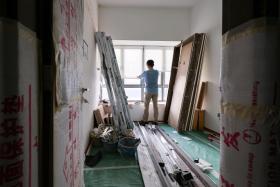No guarantee air purifiers can remove ‘new house smell'
SINGAPORE – There is “limited data” on whether air purifiers are effective in removing formaldehyde, the chemical that causes the “new house smell”, said the National Environment Agency (NEA).
It urged consumers to be cautious when choosing an air purifier to remove formaldehyde, and said they should first opt for environmentally friendly building materials and ventilate confined spaces to clear the chemical.
Experts told The Straits Times that while air cleaners can clear formaldehyde, they questioned the effectiveness of the devices in most household settings as airflow and room size, among other factors, can affect the removal of the chemical.
The experts and NEA were responding to ST’s queries about advertisements from various manufacturers claiming that their air purifiers can remove formaldehyde.
The ads include those from Xiaomi, Dyson, Plasma Science and Sterra.
Home-grown company Sterra claimed in a Facebook ad that its Sterra Breeze Pro air purifier could “permanently remove formaldehyde 2x better than others”.
The chemical, often found in resins and glues used in wooden furniture, as well as in composite wood products such as plywood and fibreboard, can cause irritation of the eyes, nose and throat, with long-term exposure linked to certain cancers.
NEA said: “As there is currently limited data on the effectiveness of air purifiers in removing volatile organic compounds, such as formaldehyde, occupants (of affected spaces) are advised to, first and foremost, reduce sources of formaldehyde indoors by choosing low-emission building products that are certified with the Singapore Green Labelling Scheme or the Singapore Green Building Product Certification Scheme.”
The schemes are certifications for products made in an environmentally friendly way.
NEA added that as at Sept 4, it has not received any complaint about advertisements for air purifiers claiming to remove formaldehyde.
A spokesman for the Advertising Standards Authority of Singapore (Asas) said the regulator is seeking clarification from Sterra on its ad that the Breeze Pro air purifier can remove the chemical two times better than other devices.
On the clarification process, Asas chairman Bryan Tan said the manufacturer has to provide reports from tests by independent agencies to prove its claim that its product is able to remove formaldehyde permanently. These reports will be reviewed by Asas and a panel of experts.
Sterra co-founder Chris Lim told ST that the company stands by its claims on the effectiveness of Breeze Pro. He said it could remove 10.76 per cent of formaldehyde content in a laboratory test, compared with the 3.97 per cent by the cheaper Sterra Moon purifier. This validated the claim that Breeze Pro is “indeed (more than) two times stronger”, he noted.
Mr Lim added: “Whilst we stand by the claims provided by the laboratory test results, we have temporarily paused our advertisements to cooperate with the investigations.”
Mr Tan said on Sept 6 that it has not yet received Sterra’s supporting documents and will review them to determine if the claim is supported.
Sterra had earlier come under scrutiny over false claims that Singapore’s tap water was unsafe without the use of its water purifiers.
Other manufacturers also stood by their claims.
The Agency for Science, Technology and Research, which collaborated with Plasma Science to develop air cleaners under the brand Trident, pointed to findings by an independent test lab of Trident’s purifiers. The devices reportedly reduced the level of total volatile organic compounds, including formaldehyde, by up to 75 per cent in indoor conditions.
Xiaomi said the removal rate of formaldehyde in real-world environments cannot be guaranteed due to dynamic factors like humidity and ventilation and recommended using a formaldehyde sensor to judge the removal effect.
Dyson lead electronics engineer Lee Dai Jin noted that the sensor on Dyson’s purifiers are able to determine the removal rate for formaldehyde, recorded at up to 100mg per cubic metre each hour. For instance, the Dyson Purifier Big+Quiet Formaldehyde model contains sensors to monitor particles, temperature and gases to provide a precise formaldehyde reading.
Manufacturers usually include caveats about the effectiveness of their devices, stating that the results may vary in practice.
NEA said in August that since 2020, it has received 19 cases of feedback on formaldehyde levels arising from renovation works.
Get The New Paper on your phone with the free TNP app. Download from the Apple App Store or Google Play Store now


